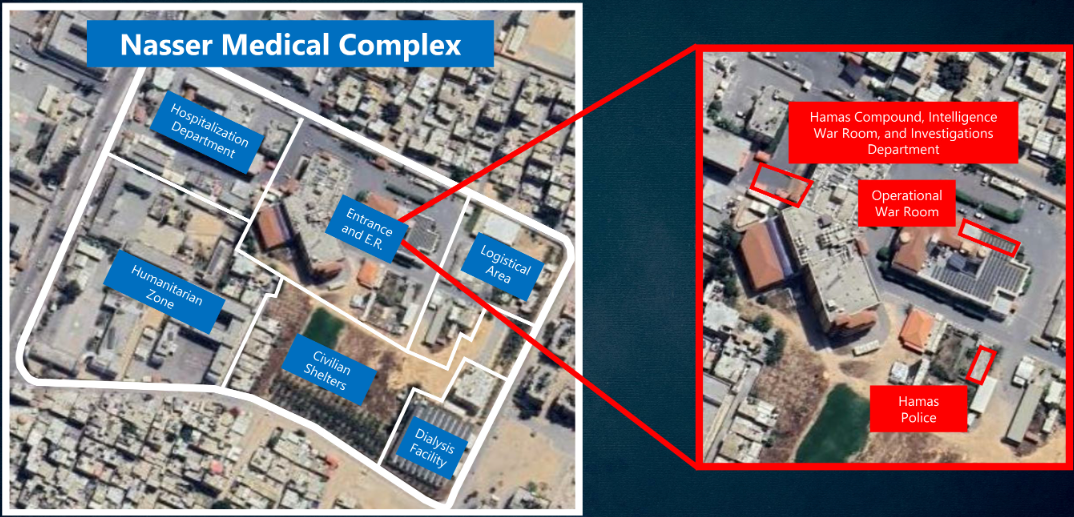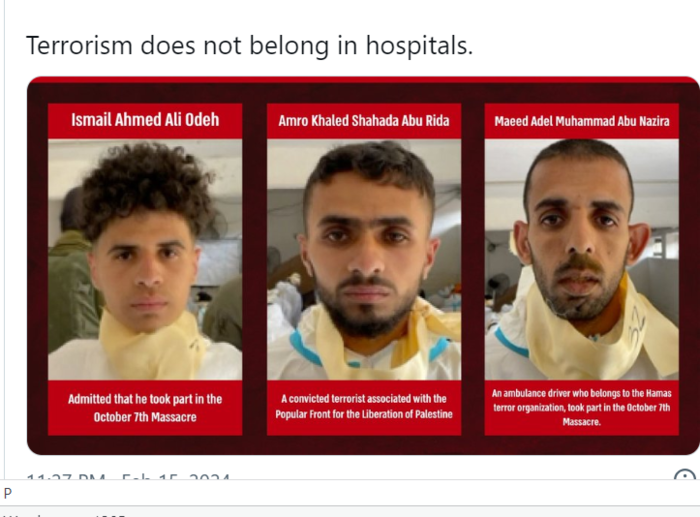A 1400 plus word article in the Guardian on the challenges to Gaza’s healthcare co-written by a Palestinian surgeon named Dr Osaid Alser not only blamed Israel (and only Israel) for the problems facing doctors and patients in the territory, but managed to avoid using the word Hamas even once. Though it would occur to many that perhaps the Guardian contributor avoided calling out the proscribed terror group out of fear for this safety, it turns out that Dr. Osaid, like his co-author, Dr Simon Fitzgerald , is based in the United States, not Gaza.
The propaganda piece (“We started a group chat to help fellow doctors in Gaza. Then it went quiet”, Feb. 25) begins by describing their role:
In late January we helped organize a group chat between physicians from across the globe and Dr Khaled Alser, the only general surgeon remaining at Nasser hospital in the south of Gaza.
The authors then begin to describe some of the wounded patients they assisted Dr. Alser with, before the topic turned to Nasser hospital, in Khan Younis, where IDF believed some of the Israeli hostages had been held, and where some dead hostages were buried.
The Guardian piece claims the following:
While we reviewed these clinical cases many of us realized the threat looming over the hospital and the doctors on the other end of our group chat. We knew the violence targeting hospitals and healthcare workers was shifting south toward Nasser hospital. But it was still shocking when, in early February, the chat shifted from clinical images of patients to requests that we pray for the staff’s safety.
However, what’s described as “the violence targeting hospitals and healthcare workers”, which any ‘respectable’ Guardian reader would understand as IDF violence, was caused by Hamas, as evidenced by the fact that rocket fire from within the grounds of the Nasser hospital had been documented a month earlier, and that battles between Israeli troops and Hamas gunman who were positioned at Nasser hospital raged for days during the time in February the contributors mentioned.

In fact, more evidence that terror groups were illegally operating out of Nasser Hospital, or using the facility for protection, is found in IDF reports that its soldiers detained over 100 terror suspects while operating there, including over 20 who they believed participated in the Oct. 7 massacre – some of whom were named by according to the IDF:
These are the faces of the 3 Hamas terrorists who hid behind innocent civilians and held Israeli hostages in a hospital.
Terrorism does not belong in hospitals. pic.twitter.com/uyOUjvJ5xl
— Israel Defense Forces (@IDF) February 15, 2024
Also omitted from the Guardian article is the fact that soldiers uncovered a large quantity of weapons, as well as medicine that was supposed to be delivered to the Israeli hostages, was also found at Nasser.
🚨Nasser Hospital and Hamas: Update 🧵
Within the hospital, the @IDF discovered numerous weapons, some hidden in vehicles used by Hamas terrorists for the October 7th massacre.
1/4 pic.twitter.com/M3M4ZZq3VR— COGAT (@cogatonline) February 18, 2024
Moreover, Guardian readers also aren’t told that – in order to avoid civilian casualties – on January 26th the IDF had advised civilians taking shelter at the Nasser hospital (as opposed to the patients) to leave, and gave instructions on the appropriate evacuation route they should take.
The Guardian continues:
The last series of messages in the group detailed an onslaught of patients injured on hospital grounds, including a video sent by the surgeon to our chat of an operating room nurse who was shot in the chest while working in the surgical wing of the hospital.
However, it appears that the allegation that a nurse was shot in the chest – again, presumably by Israeli soldiers – appears to be based on a statement by the UN, citing comments by the Hamas-run health ministry. Indeed, it’s telling that the contributors don’t bother providing a source to back up their claim.
The article continues:
As the security situation of the hospital deteriorated and the internet became spotty, Alser left us audio messages detailing Israeli orders to leave the hospital or face the threat that the hospital would be bombed
This appears to be complete disinformation. The hospital was never bombed, and, according the IDF, patients and doctors were never ordered to evacuate.
The article then falsely claims that the hospital was in fact bombed. Not only were we able to find any credible claims – even by the UN and other bodies generally hostile to Israel – that the hospital itself was fired on by Israeli forces, the IDF facilitated the transfer of food, water, baby formula, medical supplies and equipment, including oxygen, as well as fuel to the hospital.
The article’s unevidenced allegations continue:
A subsequent attack by an armed drone shot one of the doctors we had been supporting in the head. While this doctor should experience a good recovery, the bullet was centimeters from killing him.
We could find not report of this incident occurring, even in reports on the Nasser Hospital operation posted by the NGO Doctors Without Borders. – and, again, the authors provide no source.
The article then proceeds with another lie:
Alser sent us videos of patients who died when their life support failed because of interruptions of electricity and oxygen imposed during the siege of the hospital.
Here’s the IDF statement issued on Feb. 16 in response to claims regarding the “imposed” electricity interruption:
IDF statement: IDF troops and the Coordination and Liaison Administration for Gaza (CLA) are operating against the Hamas terrorist organization in the area of Nasser Hospital in Khan Yunis. During the
precise and limited operational activity inside Nasser Hospital, medications… pic.twitter.com/vCqqrOeGbJ— Joe Truzman (@JoeTruzman) February 16, 2024
The Guardian proceeds with more disinformation:
We fear their fate may be similar to the premature babies left to die and rot in isolation in al-Nasr pediatric hospital in Gaza City after it was forced to evacuate [in early December].
The contributors omitted the emphatic IDF denials which were widely reported at the time of the allegations. The IDF said that “it did not operate inside the Al-Nasr hospital,” and that “these allegations are not only false but also a perverse exploitation of innocent lives, used as tools to spread dangerous misinformation.” The statement went on to clarify that the “IDF assisted in moving newborns from the pediatric ward of the Shifa hospital to safety, as well as provide Israeli incubators in the process”.
More deceit from the Guardian:
From other news media, we saw images of Israeli soldiers occupying Nasser hospital, placing many healthcare workers in custody and leaving the facility out of service.
The only people held in custody were those accused of being affiliated with Hamas, or of having participated in the Oct. 7 attacks. Further, as we noted previously, the IDF was clear that the facility was never out of service.
Then, the Guardian contributors write the following:
There is a split in the international medical community over how to engage with the ongoing war in Gaza. Many have chosen not to engage at all, but for those of us on this chat, there has been solidarity evolving since October, when the British-Palestinian plastic surgeon Dr Ghassan Abu Sittah stood at a podium at an impromptu press conference surrounded by bodies, civilians killed in an explosion on the campus of the Ahli Baptist hospital.
Guardian readers aren’t informed that Dr. Ghassan Abu Sittah “stood at the podium and lied”, falsely claiming that an Israeli bomb hit the hospital, when, as even Human Rights Watch later admitted, it was an errant PIJ rocket that struck the area outside the medical facility. Evidently, for the two Guardian contributors, “solidarity” is defined by spewing pro-Hamas propaganda
The propagandistic messaging continues:
[The IDF has engaged in the] systematic destruction of the healthcare infrastructure for Palestinians in Gaza, and that has been repeated from north to south.
Unable to mention the word Hamas, the co-authors obfuscate that the terror group is the party who has systematically exploited hospitals in Gaza, using them to shield terrorist activities such as tunnels, and moving hostages to them in the wake of the October 7 attack. Israeli intelligence estimates concluded that Hamas has used 85 percent of medical facilities in Gaza.
In the four months of monitoring the Guardian’s coverage of the war, this likely ranks in the top ten in terms of pieces that have peddled what is effectively pro-terror propaganda, without even an attempt at objectivity, balance or journalistic integrity. For Hamas, the Guardian continues to be the gift that keeps on giving.
Related Posts
The Guardian’s egregious double standards in reporting on sexual violence





